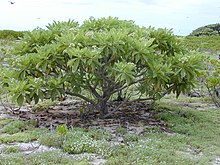| Heliotropium arboreum | |
|---|---|

| |
| In the Hawaiian Islands | |
| Conservation status | |
 Least Concern (IUCN 3.1) | |
| Scientific classification | |
| Kingdom: | Plantae |
| Clade: | Tracheophytes |
| Clade: | Angiosperms |
| Clade: | Eudicots |
| Clade: | Asterids |
| Order: | Boraginales |
| Family: | Boraginaceae |
| Genus: | Heliotropium |
| Species: | H. arboreum |
| Binomial name | |
| Heliotropium arboreum (Blanco) Mabb. | |
| Synonyms | |
| |
Heliotropium arboreum is a species of flowering plant in the borage family, Boraginaceae. It is native to tropical Asia including southern China, Madagascar, northern Australia, and most of the atolls and high islands of Micronesia and Polynesia. Common names include velvetleaf soldierbush, tree heliotrope, veloutier, and octopus bush. It is a shrub or small tree typical of littoral zones reaching a height of 3.6 m (12 ft), with a spread of about 5 m (16 ft).
Taxonomy
Originally published as Tournefortia argentea, it was transferred to Argusia argentea, and remained under that name until recently. It was subsequently restored to the genus Tournefortia before being transferred into the genus Heliotropium under a new name in 2003.
Botanical description
The tree heliotrope is a small to medium sized growing tree that typically reaches heights of 3.7 metres (12 ft). The leaves of this tree are light green in color, silvery in sheen, and silky in texture. The tree produces small fruits and flowers during its bloom, (May through November). The flowers are tiny, only reaching 0.61 centimetres (0.24 in) in diameter, white, and do not begin to appear until the tree has reached a few years of age. The fruits it produces are small, opaque and fleshy. The bark is light gray/brown and is corrugated.
Uses
Wood
The wood of H. arboreum is commonly used to make handicrafts, tools, and, in Polynesia, frames for swim goggles. Due to its availability, H. arboreum is used as firewood, and has become rare in some areas as a result.
Leaves
In the Marshall Islands, corpses are washed in water soaked with the leaves of the tree heliotrope to mask smells. The leaves are used as a spice on some islands, and can also be eaten raw as a salad. In Kiribati, oil from the leaves is used to make deodorant.
Medicinal
Octopus bush is used in many Pacific islands as a traditional medicine to treat ciguatera fish poisoning, which is caused by powerful ciguatoxins produced by microscopic Gambierdiscus algae. Scientists from the Institute of Research for Development (IRD) and the Louis Malarde Institute in French Polynesia and Pasteur Institute in New Caledonia are researching the plant chemistry and believe that senescent leaves contain rosmarinic acid and derivatives, which are known for its antiviral, antibacterial, antioxidant, and anti-inflammatory properties. The researchers think that rosmarinic acid removes the ciguatoxins from their sites of action, as well as being an anti-inflammatory agent.
Coastal protection
The preferred growing conditions of H. Arboreum are in the littoral zone. It thrives in sandy barren soil with high drainage. It is capable of withstanding sea spray, and can grow in heavy winds. The tree is also a drought resistant variety, allowing it to survive the subtropical dry season of the South Pacific. These factors, plus the roots of "H. Arboreum" taking hold in the sand, help stabilize the shore, mitigating coastal erosion.
References
- Razafiniary, V.; Hills, R. (2021). "Heliotropium arboreum". IUCN Red List of Threatened Species. 2021: e.T165436903A165436944. doi:10.2305/IUCN.UK.2021-1.RLTS.T165436903A165436944.en. Retrieved 16 November 2021.
- NRCS. "Tournefortia argentea". PLANTS Database. United States Department of Agriculture (USDA). Retrieved 11 December 2015.
- Hilger, Hartmut H. (1 December 2003). "IngentaConnect A systematic analysis of Heliotropiaceae (Boraginales) based on t". Botanische Jahrbücher. 125: 19–51. doi:10.1127/0006-8152/2003/0125-0019.
- "Heliotropium foertherianum Diane & Hilger". Australian Plant Name Index (APNI), IBIS database. Centre for Plant Biodiversity Research, Australian Government.
- ^ Manner, Harley I. "Tournefortia Argentea (Tree Heliotrope)". Species Profile for Pacific Island Agroforestry, Apr. 2006
- ^ Montoya, John Edward, and Richard Criley. "Expanding Tree Diversity in Hawai'i's Landscapes: Beach Heliotrope, Tournefortia Argentea". University of Hawai'i, Mar. 2014.
- Rossi F, Jullian V, Pawlowiez R, Kumar-Roiné S, Haddad M, Darius HT, Gaertner-Mazouni N, Chinain M, and Laurent D (August 2012). "Protective effect of Heliotropium foertherianum (Boraginaceae) folk remedy and its active compound, rosmarinic acid, against a Pacific ciguatoxin". Journal of Ethnopharmacology. 143 (1) (published 30 August 2012): 33–40. doi:10.1016/j.jep.2012.05.045. PMID 22706150.
External links
| Taxon identifiers | |
|---|---|
| Heliotropium arboreum |
|
| Tournefortia arborea | |
- IUCN Red List least concern species
- Heliotropium
- Australasian realm flora
- Eudicots of Western Australia
- Flora of Ashmore and Cartier Islands
- Flora of Christmas Island
- Flora of India (region)
- Flora of Malesia
- Flora of Queensland
- Flora of the Coral Sea Islands Territory
- Flora of the Maldives
- Flora of the Northern Territory
- Flora of the Pacific
- Flora of the Tubuai Islands
- Flora of the Western Indian Ocean
- Flora of Vietnam
- Indomalayan realm flora
- Lamiales of Australia
- Leaf vegetables
- Least concern biota of Asia
- Least concern biota of Queensland
- Least concern flora of Australia
- Least concern flora of Oceania
- Least concern plants
- Oceanian realm flora
- Trees of Australia


